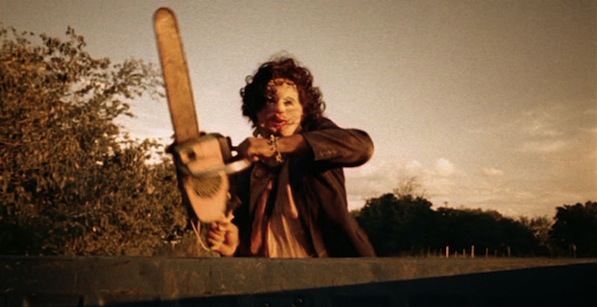
The Texas Chainsaw Massacre (1974)
While Halloween provided the narrative and thematic blueprint that many succeeding horror films would copy, The Texas Chainsaw Massacre’s nihilistic ethos would later become the cornerstone of the slasher genre. Leatherface killed without warning and without reason. Everything that films like Friday the 13th and its attendant imitators know was learned from Tobe Hooper’s spin on the real-life story of Ed Gein, the serial killer who also inspired both Psycho and The Silence of the Lambs.
Halloween (1978)
Autodidact John Carpenter’s proto-slasher gave the horror world its first icon in the form of masked killer Michael Meyers. Carpenter’s film takes cues from Psycho and periodically sutures the viewer’s POV into that of Michael’s victims. The film’s portrayal of Michael as the ne plus ultra boogeyman has sustained it, including countless sequels, two remakes and scads of other titles that play by the generic rules that Carpenter’s film established.
The Evil Dead (1981)
Sam Raimi’s break-out film made an irrevocable mark for its slapstick-heavy gross-out humor and inability to take anything seriously. That “spook-a-blast” sense of humor is equal parts indebted to The Three Stooges and the tacky carnival rides of Raimi’s youth. Raimi would remake his spastic horror comedy as Evil Dead II and then later as Army of Darkness, all three of which circulated via midnight screenings and bootleg tapes. The Evil Dead remains a definitive cult film, establishing C-list star Bruce Campbell as a living legend.
The Blair Witch Project (1999)
Films like The Last House on the Left and The Texas Chainsaw Massacre were grotty enough to fool people into thinking that they were assembled from found footage, The Blair Witch Project’s main innovation is that it deliberately presented footage of a trio of missing twenty-somethings as raw, unedited footage. The film established shaky cam as a unshakable vestige of post-millenial horror films, and also created its own subgenre of horror films where moronic characters film their own deaths, ostensibly for posterity’s sake.
Saw (2004)
For better or worse, Saw has had a tremendous impact on pop culture in the last six years. Its considerable box office success (it was didn’t cost much to make, after all) made it the cornerstone of the so-called ‘torture porn’ trend. Six sequels later, Saw remains the most visible and hated film of the moral panic du jour ever since. When people talk about quality in horror, the use of gimmicks or the amount of gore in a film, they usually have Saw in mind, even if they haven’t even seen it. Sometimes, importance can be measured in overwhelming unqualified hate.
Simon Abrams is a NY-based film, tv and comics critic for various outlets, including the Village Voice, the Onion’s A.V. Club and Wide Screen. He collects his writing on film at Extended Cut.





